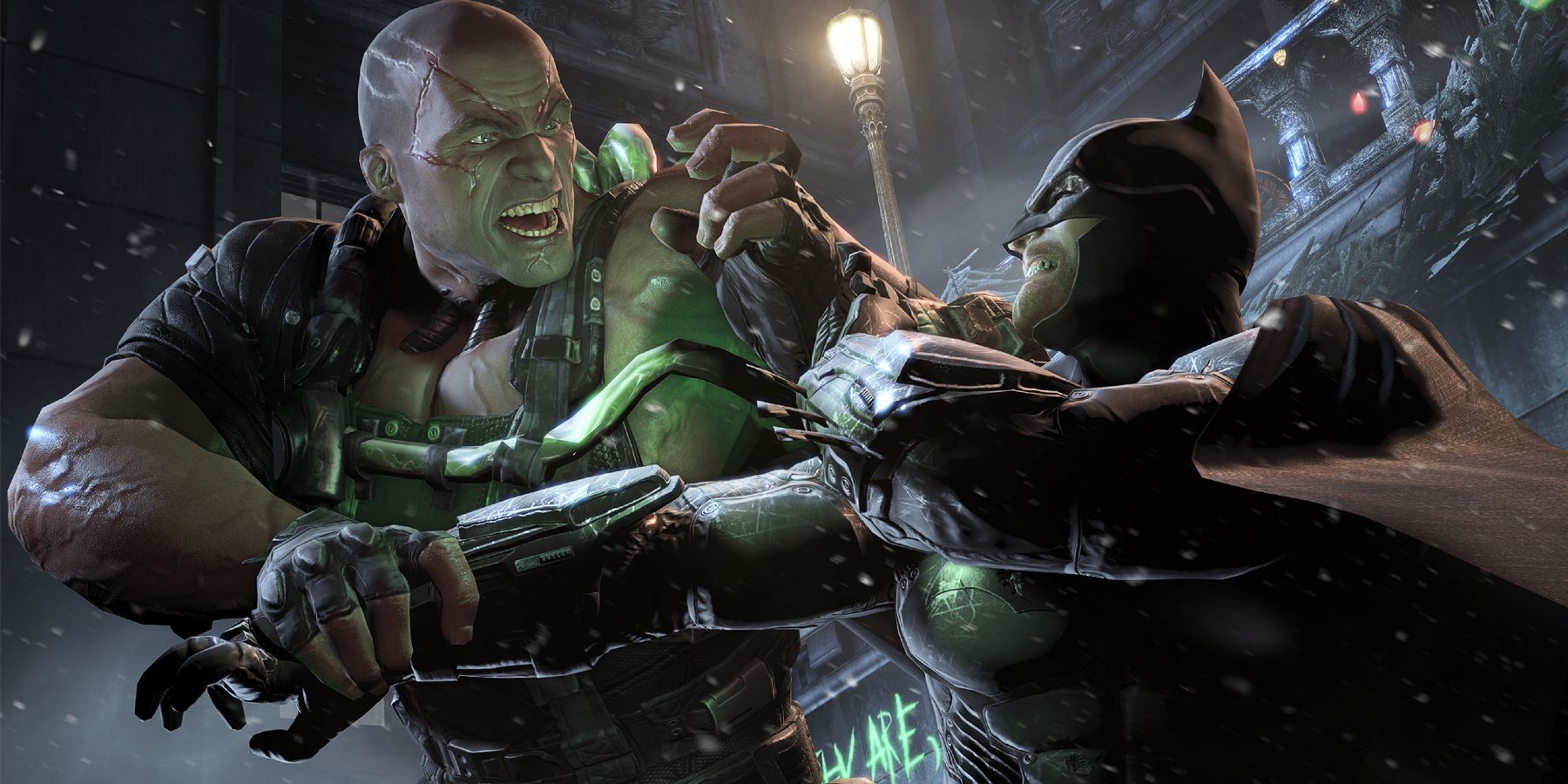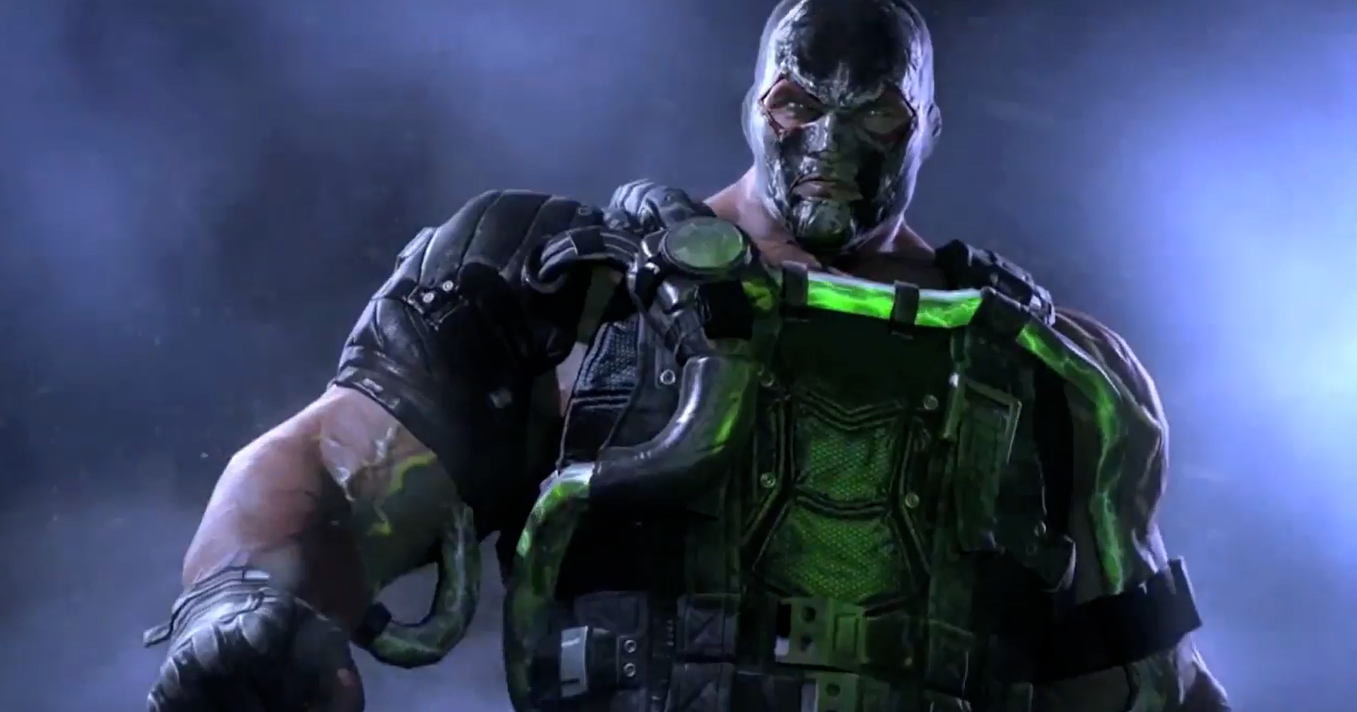Batman: Arkham Asylum’s Bane is no more imposing or difficult to fight than an ordinary TITAN brute, and he is interpreted as a dullard enslaved to Venom. Bane’s importance to the narrative is only through his connection to the musculoskeletal enhancement drug, and the TITAN formula that Dr. Penelope Young produces in order to create more Bane-esque brutes. Bane is then removed from Batman: Arkham Asylum as the Batmobile sends him into the water. This Bane is easily forgettable in Rocksteady’s Batman: Arkham trilogy as a result.
Bane returns briefly in Batman: Arkham City, but his side mission is optional, insignificant, and adds nothing to the character. So when Bane was first revealed as a villain in WB Games Montreal’s Batman: Arkham Origins, it would have been fair to assume that players would be less excited about his addition. Instead, Batman: Arkham Origins is partly an origin story for Bane’s character in the Batman: Arkham canon that takes many liberties with the character and creates an awkward dissonance between Batman: Arkham Asylum and Batman: Arkham Origins.
Bane's Character Is More Fleshed Out in Batman: Arkham Origins
Bane, one of the many supervillains Batman’s illustrious rogues’ gallery, is a fairly simple on paper. Bane’s traditional appearance is denoted by his luchador-esque mask, Latino ethnicity, and abnormal super-strength, which stems from the hyperactive performance drug Venom. Batman: Arkham Origins’ Bane is closer to the character’s canonical comic book source material, where he is an intelligent strategist with an IQ of 187 and already physically gargantuan.
Bane is announced as one of Black Mask’s eight assassins who have come to Gotham City on Christmas Eve to kill Batman for $50 million. Batman even makes note of how peculiar it is that Bane is in Gotham, which establishes the idea that Batman is at least familiar with the mercenary. In Batman: Arkham Origins' narrative, Bane ascertains Batman’s true identity and uses it to find the Batcave, where he goads Batman by murdering Alfred. Bane actually wants Batman to kill him in order to fracture Batman’s moral code.
This is a more sinister and strategic Bane than most modern interpretations, at least narratively. Players first encounter Bane in the immense Gotham Royal Hotel. Here, the boss fight itself is not unlike common brute fights from Batman: Arkham City, and is trivialized through a repeated use of active finishers. But once the fight progresses to the hotel’s rooftop balcony, Bane repeatedly injects himself with Venom to perform lunging rushes and Area of Effect ground attacks.
Bane's Boss Fights Escalate to Match Batman: Arkham Origins' Narrative
Bane’s speed is surprising in the hotel fight's second phase because speed is not necessarily a common characteristic of the character, and especially not in Rocksteady’s iterations. Bane is typically outmatched by Batman’s batarangs and simple somersaults. This is no longer the case in Batman: Arkham Origins; in their final encounter, Batman resuscitates Bane using Electrocutioner’s shock gauntlets. Infuriated by Batman’s morality loophole, Bane injects himself with TN-1 and becomes the hulking monstrosity more familiar to Batman: Arkham fans.
Batman: Arkham Origins' overpowered TN-1 Bane stalks tight corridors in a tense stealth sequence that also happens to be the first instance where Bane is treated as a foe players cannot simply cape stun or dodge around. Players must hide within ventilation ducts and beneath floor grates in order to achieve stealth takedowns. Each stealth takedown must be followed up by slamming Bane into a nearby electrical outlet and subsequently beating him down to deplete his health.
Bane suffers memory loss as a result of severe brain trauma, which is a clever and quick way of suggesting how Bane becomes a brutish oaf in Batman: Arkham Asylum. This can be looked at in a couple ways: on the one hand, players might be happy to see that Batman: Arkham Origins made an attempt to line up its wildly unique take on Bane with Batman: Arkham Asylum’s Bane.
On the other hand, it is disappointing to see Bane’s interesting character devolve into the fodder character that he becomes in Batman: Arkham Asylum, though this also makes for a more tragic and somewhat empathetic throughline. By contrast, the final boss fight against Joker follows this fight and is diminished to repeatedly mashing the punch button.
Bane Overshadows the Joker in Batman: Arkham Origins
Batman: Arkham Origins’ Joker always had a lot to live up to in terms of Troy Baker’s stab at the character. Following Mark Hamill’s historic performances as the Joker are shoes no actor could easily fill, but Baker’s performance as the Joker in Batman: Arkham Origins is surprisingly competent and fresh, even if his Joker seems like another iteration entirely.
Batman: Arkham Origins tells the origin story for the Joker’s relationship with Batman and how the two meet in this canon, meanwhile Bane's contribution to the narrative is more involved. Joker's popularity also comes with saturation, and it is refreshing to see another antagonist take on a similarly substantial role in Batman: Arkham Origins.
Bane could have easily been sidelined through Batman: Arkham Origins’ Most Wanted side missions along with many of the other Black Mask assassins. After all, Bane had served as side-villain fodder before. Shiva, Copperhead, Deadshot, and Electrocutioner are all forgettable villains and join the forgettable ranks of Anarky, Bird, and Mad Hatter. Some of these side missions are fun if not short, but ultimately feel like repetitive or redundant ways to occupy Gotham City’s open-world.
Batman’s entire arc in Batman: Arkham Origins deals with him learning how to work with other like-minded individuals in Gotham. Batman's contentious relationship with Alfred is mended after Batman revives him, and they reconcile over their desire to save the city. Bane inadvertently reinforces this character development and also challenges Batman’s moral code. Further, his boss fights are suspenseful and truly emergent once he becomes saturated with the TN-1 formula.
The Joker is superfluous compared to Bane’s narrative substance. Batman: Arkham Origins could have centered Bane as its chief antagonist, and would have been all the better for it, though his chronological return in Batman: Arkham Asylum will always feel lackluster when his drastic change in character is acknowledged.




.png)